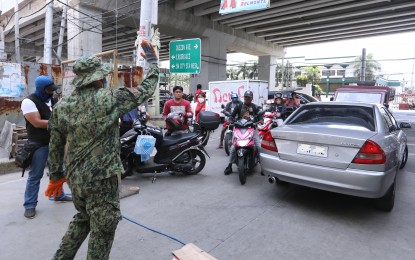
WINDOW HOURS. Police and barangay personnel strictly enforce the "window hours" for going out in Barangay Tatalon along Kaliraya Street and Araneta Avenue, Quezon City on Thursday (April 23, 2020). According to the Quezon City government, residents are allowed to leave their homes for essential errands from 7 a.m. to 11 a.m. and from 2 p.m. to 6 p.m. as part of the quarantine measures. (PNA photo by Joey O. Razon)
MANILA – Members of the Inter-Agency Task Force for the Management of Emerging Infectious Diseases (IATF-EID) are expected to discuss the quarantine protocols that will be implemented in areas that are under enhanced community quarantine (ECQ) and general community quarantine (GCQ), Malacañang said Sunday.
Presidential Spokesperson Harry Roque said IATF-EID members will meet on Monday to thresh out the action plans of the government to effectively contain the coronavirus disease 2019 (Covid-19) in the country.
“Importante na po ‘yung mga protocol na ibibigay ng iba’t ibang klaseng groups para dun sa areas na magkakaroon ng GCQ (It’s important to know the protocols that will be recommended by different groups for areas that will be placed under GCQ),” Roque said in an interview with DZBB.
On Thursday, President Rodrigo Duterte approved the IATF-EID’s recommendations to extend the ECQ in high risk areas for Covid-19 until May 15 and place the areas considered moderate-risk and low-risk of the coronavirus infections under GCQ from May 1 to 15.
The GCQ, or the “new normal,” is less stringent than the ECQ.
Roque explained that GCQ would also be eventually implemented in areas that are still under ECQ.
“Ang mga lugar gaya ng Metro Manila na nasa ilalim ng ECQ ay dapat makinig din dahil pag tayo po ay natapos ng ECQ tayo po ay papunta rin ng GCQ. At iyan po ay magiging equally applicable pag GCQ na tayo (When ECQ in select areas like Metro Manila ends, GCQ will be imposed. And the quarantine protocols for areas under GCQ will be equally applicable to areas [that are still under ECQ] but will eventually be under GCQ),” he said.
Metro Manila, Central Luzon, Calabarzon, Pangasinan, Benguet, Albay, Catanduanes, Davao del Norte, Davao City, Oriental Mindoro, Occidental Mindoro, Antique, Iloilo, Cebu, and Cebu City are placed under ECQ until May 15 since these are considered as high-risk areas.
The IATF-EID also classified areas into moderate-risk and low-risk of spreading Covid-19 and placed them under GCQ.
High-risk and moderate-risk areas are still subject to further evaluation.
Low-risk areas, meantime, will no longer be placed under GCQ after May 15 “if there is no deterioration.”
As of Sunday, the Philippines has 7,579 confirmed Covid-19 cases. (PNA)
Roque explained that GCQ would also be eventually implemented in areas that are still under ECQ.
“Ang mga lugar gaya ng Metro Manila na nasa ilalim ng ECQ ay dapat makinig din dahil pag tayo po ay natapos ng ECQ tayo po ay papunta rin ng GCQ. At iyan po ay magiging equally applicable pag GCQ na tayo (When ECQ in select areas like Metro Manila ends, GCQ will be imposed. And the quarantine protocols for areas under GCQ will be equally applicable to areas [that are still under ECQ] but will eventually be under GCQ),” he said.
Metro Manila, Central Luzon, Calabarzon, Pangasinan, Benguet, Albay, Catanduanes, Davao del Norte, Davao City, Oriental Mindoro, Occidental Mindoro, Antique, Iloilo, Cebu, and Cebu City are placed under ECQ until May 15 since these are considered as high-risk areas.
The IATF-EID also classified areas into moderate-risk and low-risk of spreading Covid-19 and placed them under GCQ.
High-risk and moderate-risk areas are still subject to further evaluation.
Low-risk areas, meantime, will no longer be placed under GCQ after May 15 “if there is no deterioration.”
As of Sunday, the Philippines has 7,579 confirmed Covid-19 cases. (PNA)
